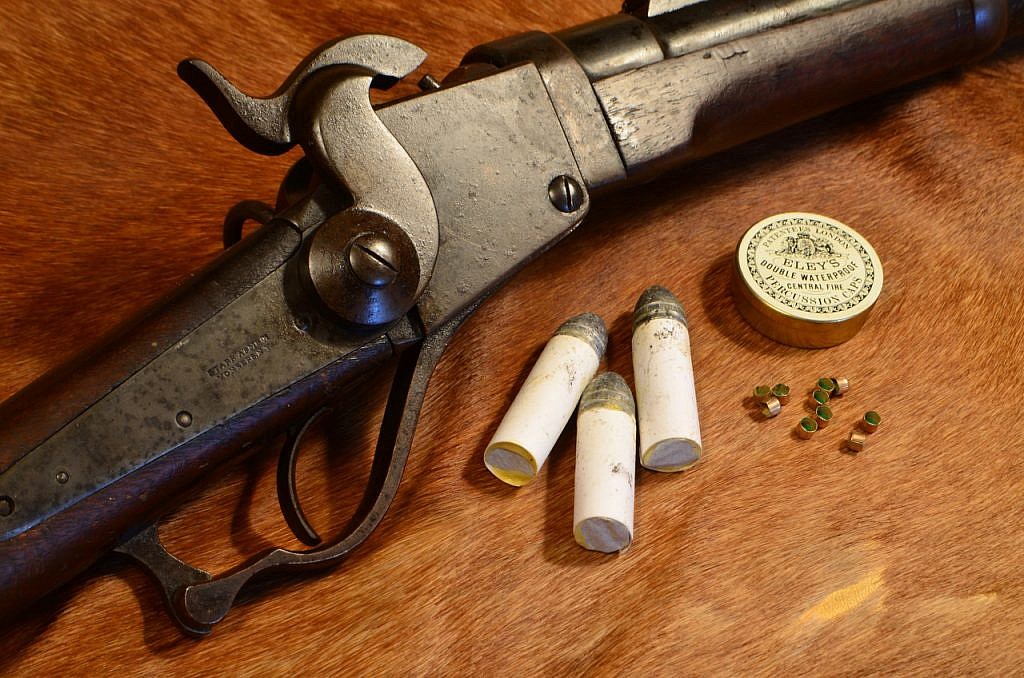
by Terry Wieland
Every so often, it’s good to delve into the past and see how things used to be done. If nothing else, it makes one grateful for how easy we have it today.
Take rifle cartridges. Between the demise of the muzzleloading caplock rifle, and the rise of the self-contained brass cartridge, there were any number of dead ends, false leads, hopeful failures, and halfway houses on the long and winding road to modern brass cases, non-corrosive primers, smokeless powder, and bullets that fly true and group into tiny circles at 500 yards.
To wit: the Starr carbine, a Civil War veteran, short of lifespan and small in numbers, but still a notable stop on the road to the breechloading cartridge. The action was designed by Ebenezer Starr, patented in 1858, sent for army trials, and a few thousand were ordered, delivered, and employed by Union cavalry during the war.

Outwardly, it resembles the Sharps of that era, with a falling breechblock that rocks to the rear. A paper cartridge with a .540 bullet is stuffed into the chamber. As the breechblock rocks tightly into position, a cutting edge in its face perforates the paper. This cutting edge surrounds the flash hole. A percussion cap is placed on the conventional nipple, and the flame travels through the breechblock’s flash hole to ignite the exposed powder.
In 1858, this was noteworthy; by 1864, it was outmoded. Starr tried to adapt the design to solid cartridges, but it was rejected after army trials and the company folded.
Making cartridges for the Starr is not particularly difficult. You roll a tube out of heavy paper (or light cartboard). The bullet goes in one end and is glued in place. The base is formed by a small cup made of lighter paper, and the space in between is filled with gunpowder. Generally, it is better to fit the paper cup, fill it with powder, then insert the bullet. The whole thing is held together with glue and it should be as firmly packed as a sausage, so the paper base will present some resistance. Otherwise, the cutting edge merely pushes at the paper base.

There are the two critical elements: The cutting edge in the breechblock, and the paper cup it must perforate. If the paper is too light, it’s not durable enough to be bounced around in a saddlebag; if it’s too heavy, the cutting edge can’t break through it, and the flame won’t penetrate. The result is a misfire.
The cutting edge is critical, and also the most vulnerable. It can easily be crushed, it is subject to fouling from both the powder and the percussion cap, and corrosion blunts a sharp edge in a heartbeat. The good news is that, if the cutting edge fails, the shooter has a couple of options. Assuming the paper is not too thick, the first percussion cap will scorch the paper, and a second almost always then penetrates it. Another option is to perforate the paper with a knife tip after the cartridge is in the chamber, then close the breechblock.
Finally, a shooter is not entirely dependent on the paper cartridge at all. You can simply open the breech with the barrel pointing down, drop in a bullet, fill the chamber with powder, and close the breech. Not ideal, but it works.
For this reason, the Starr carbine was a good choice for anyone who might find himself far from civilization, with only bullets, powder, and percussion caps. In the long run, this made it superior to the early breechloaders with self-contained brass cartridges. And, at close range, there’s not much that heavy .540 ball won’t stop.
______________________________________________________________________________
Gray’s shooting editor Terry Wieland is an inveterate fiddler with the weird ways in which guns go bang. It keeps him out of the saloons.
